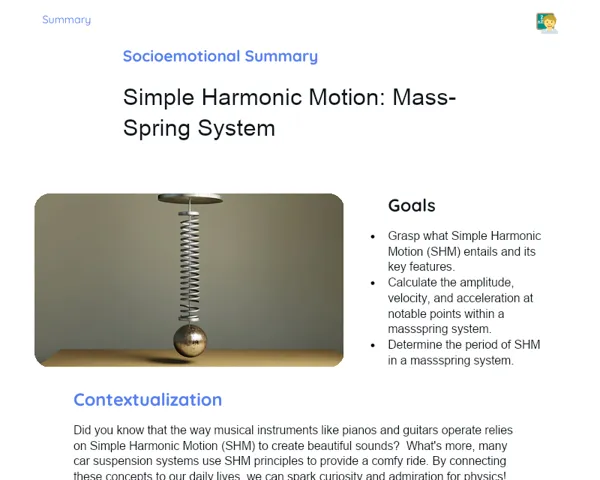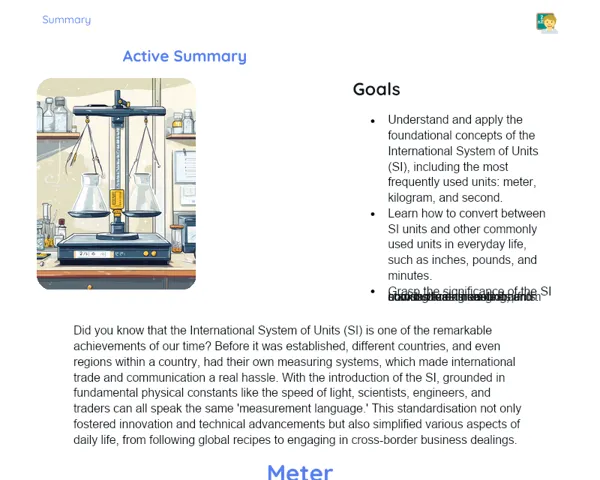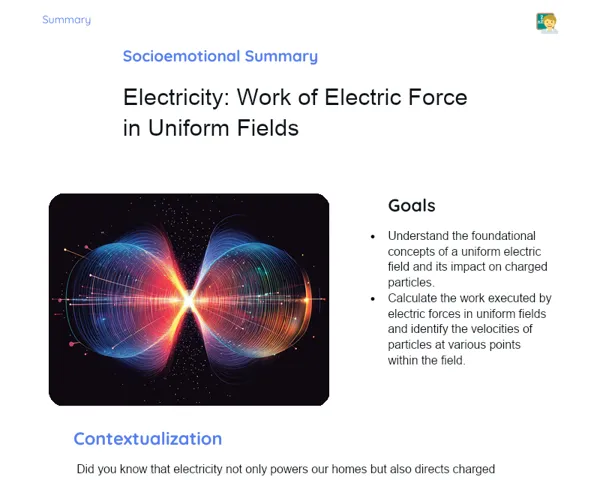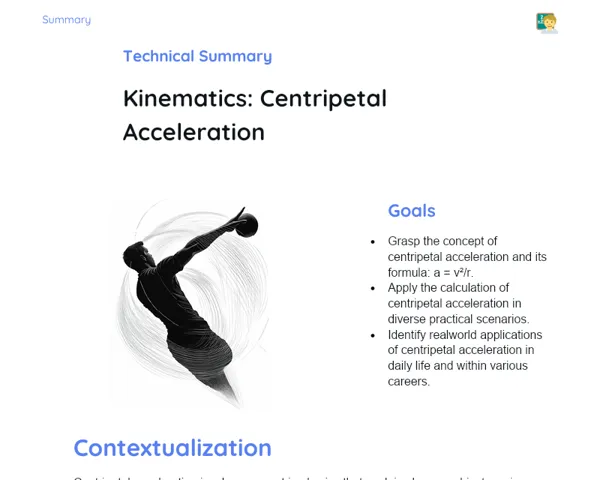Summary Tradisional | Waves: Refraction
Contextualization
Refraction is a fascinating occurrence that takes place when a wave changes its direction while moving from one medium to another with different densities. This happens due to the varied speeds at which waves travel through different substances, leading to a shift in the wave's path. A familiar example of refraction can be seen when a straw appears to 'bend' in a glass of water. This optical illusion happens because of the change in light's direction as it transitions from air to water, which have distinct refractive indices.
Beyond being an intriguing phenomenon, refraction plays a critical role in our everyday lives and in cutting-edge technologies. For example, the way lenses and glasses work is dependent on refraction, helping to correct vision issues by focusing light correctly onto the retina. Another practical application is the use of optical fibres in communication systems, where refraction and total internal reflection are exploited to transmit data effectively. Furthermore, natural events like rainbows are products of light refraction as it passes through raindrops, showcasing the beauty and intricacy of this physical process.
To Remember!
Definition of Refraction
Refraction is what happens when a wave alters its direction as it moves from one medium to another with differing densities. The wave slows down and its path adjusts as it transitions from a less dense medium to a denser one, becoming closer to the normal line (which is perpendicular to the boundary of the two media). Conversely, if a wave travels from a denser medium to a less dense one, it speeds up, and its direction strays from the normal line.
It's crucial to note that refraction isn’t just limited to visible light; it also applies to other wave types, such as sound waves and radio waves. For instance, when a sound wave moves from air into water, its speed alters, changing how the sound propagates.
We see the effects of refraction in many daily occurrences—from how we view objects submerged in water to the formation of mirages in deserts. Understanding refraction lays the groundwork for grasping a wide array of optical and acoustic phenomena.
-
Refraction happens when a wave alters its direction while moving from one medium to another with differing densities.
-
The change in direction arises from the variance in wave speeds within different media.
-
Refraction applies to various wave types, including visible light, sound waves, and radio waves.
Snell's Law
Snell's Law is essential for understanding and calculating how waves refract. It connects the angles of incidence and refraction to the refractive indices of the involved media. The basic formula is n1 * sin(θ1) = n2 * sin(θ2), where n1 and n2 represent the refractive indices of the first and second media respectively, and θ1 and θ2 are the respective angles of incidence and refraction.
This law is named after Willebrord Snellius, a Dutch mathematician who formulated it in the 17th century. Understanding Snell's Law allows us to predict accurately how a wave will refract when passing between different media, which is vital for designing lenses and other optical devices.
The practical applications of this law are vast, covering areas from vision correction with glasses to creating optical fibres used in telecommunications. With Snell's Law, we can determine the necessary angle of refraction to direct light efficiently in various technological uses.
-
Snell's Law connects the angles of incidence and refraction to the refractive indices of the involved media.
-
The basic formula is n1 * sin(θ1) = n2 * sin(θ2).
-
Snell's Law is crucial for designing lenses and optical devices and is widely used in telecommunications.
Refractive Index
The refractive index of a medium, represented by 'n', measures how much the speed of light or any wave diminishes when traversing that medium. It is calculated as the ratio of the speed of light in a vacuum (c) to the speed of light in the medium (v): n = c/v. A higher refractive index means light travels more slowly in that medium.
Different materials showcase varying refractive indices. For example, the refractive index of air is about 1, while that of water is roughly 1.33, and for glass, it can range from 1.5 to 1.9, depending on the type. Understanding these indices is vital when engineering lenses, prisms, and other optical devices.
Moreover, the refractive index is key to grasping light dispersion, which separates white light into its component colours, as seen in a rainbow. Each light colour has a slightly distinct refractive index, resulting in colour separation when light travels through a prism or a raindrop.
-
The refractive index is the ratio of the speed of light in a vacuum to that in the medium.
-
Different materials possess different refractive indices, influencing light propagation.
-
The refractive index is essential for designing optical devices and understanding light dispersion phenomena.
Critical Angle and Total Internal Reflection
The critical angle is defined as the angle of incidence where refraction ceases to occur, causing the full wave to reflect back into the original medium. This effect is termed total internal reflection. The critical angle is contingent on the refractive indices of the two media and is calculated with the formula: θc = arcsin(n2/n1), where n1 denotes the refractive index of the original medium, and n2 refers to that of the second medium.
Total internal reflection is applied extensively in technologies like optical fibres, which keep light contained within the fibre through total internal reflection, facilitating effective data transmission over extensive distances with minimal signal loss. This principle is also harnessed in prisms and various types of optical sensors.
In addition to its technological implementations, total internal reflection is evident in natural occurrences. For instance, the twinkling of stars results from the total internal reflection of starlight within the Earth's atmospheric layers.
-
The critical angle is the incidence angle beyond which total internal reflection happens.
-
Total internal reflection enables efficient light transmission in optical fibres.
-
Total internal reflection can also be seen in natural events such as the twinkling of stars.
Key Terms
-
Wave Refraction: Change in a wave's direction when passing from one medium to another with different densities.
-
Snell's Law: Formula linking the angles of incidence and refraction to the refractive indices of the involved media.
-
Refractive Index: Measure of how much the speed of light is reduced while passing through a medium.
-
Critical Angle: Angle of incidence at which total internal reflection occurs.
-
Total Internal Reflection: Effect where a wave is entirely reflected back into the original medium when it exceeds the critical angle.
Important Conclusions
During the lesson, we explored the phenomenon of wave refraction, which occurs when waves change their direction while passing from one medium to another with differing densities. We examined how the alteration in wave speed across various media leads to this change in trajectory and its application to different types of waves, including visible light and sound waves.
We delved into Snell's Law, which is crucial for calculating the angle of refraction and for comprehending the behaviour of light and other waves as they traverse different materials. We discussed the refractive indices of materials and their significance in designing optical devices, as well as the roles of critical angle and total internal reflection in technologies such as optical fibres.
Refraction has numerous practical and natural implications, ranging from vision correction through glasses to occurrences like rainbows and mirages. This understanding is not only vital for appreciating natural phenomena but also for advancing modern technology, underscoring the importance of studying refraction in our daily experiences.
Study Tips
-
Review key concepts of refraction, Snell's Law, refractive index, and total internal reflection with practical examples to aid understanding.
-
Practice solving exercises on calculating angles of refraction and applying Snell's Law using different materials and angles to reinforce learning.
-
Look for additional resources, such as educational videos and online simulations, to visualise and deepen your understanding of refraction and total internal reflection.



